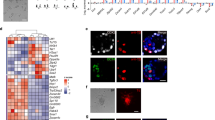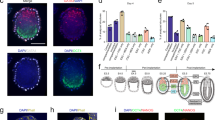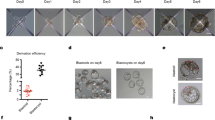Abstract
This protocol details a method to derive human embryonic stem (hES) cells from single blastomeres. Blastomeres are removed from morula (eight-cell)-stage embryos and cultured until they form multicell aggregates. These blastomere-derived cell aggregates are plated into microdrops seeded with mitotically inactivated feeder cells, and then connected with neighboring microdrops seeded with green fluorescent protein-positive hES cells. The resulting blastomere-derived outgrowths are cultured in the same manner as blastocyst-derived hES cells. The whole process takes about 3–4 months.
This is a preview of subscription content, access via your institution
Access options
Subscribe to this journal
Receive 12 print issues and online access
$259.00 per year
only $21.58 per issue
Buy this article
- Purchase on Springer Link
- Instant access to full article PDF
Prices may be subject to local taxes which are calculated during checkout



Similar content being viewed by others
References
Handyside, A.H. et al. Pregnancies from biopsied human preimplantation embryos sexed by Y-specific DNA amplification. Nature 344, 768–770 (1990).
Magli, M.C. et al. Cryopreservation of biopsied embryos at the blastocyst stage. Hum. Reprod. 21, 2656–2660 (2006).
Hardy, J., Martin, K.L., Leese, H., Winston, R.M. & Handyside., A. Human preimplantation development in vitro is not adversely affected by biopsy at the 8-cell stage. Hum. Reprod. 5, 708–714 (1990).
Staessen, C. et al. Comparison of blastocyst transfer with or without preimplantation genetic diagnosis for aneuploidy screening in couples with advanced maternal age: a prospective randomized controlled trial. Hum. Reprod. 19, 2849–2858 (2004).
Klimanskaya, I., Chung, Y., Becker, S., Lu, S.-J. & Lanza, R. Human embryonic stem cells derived from single blastomeres. Nature 444, 481–485 (2006).
Tarkowski, A., Ozdzenski, W. & Czolowska, R. How many blastomeres of the 4-cell embryo contribute to the mouse body? Int. J. Dev. Biol. 45, 811–816 (2001).
Kelly, S.J. Studies of the developmental potential of 4- and 8-cell stage mouse blastomeres. J. Exp. Zool. 200, 365–376 (1977).
Tarkowski, A.K. & Wrobleska, J. Development of blastomeres of mouse eggs isolated at the 4- and 8-cell stage. J. Embryol. Exp. Morphol. 18, 155–180 (1967).
Tarkowski, A.K. Experiments on the development of isolated blastomeres of mouse eggs. Nature 184, 1286–1287 (1959).
Tarkowski, A.K. Experimental studies on regulation in the development of isolated blastomeres of mouse eggs. Acta Theriol. 3, 191–267 (1959).
Rossant, J. Postimplantation development of blastomeres isolated from 4- and 8-cell mouse eggs. J. Embryol. Exp. Morphol. 36, 283–290 (1976).
Papaiannou, V.E., Mkandawire, J. & Biggers, J.D. Development and phenotypic variability of genetically identical half mouse embryos. Development 106, 817–827 (1989).
Deb, K., Sivaguru, M., Yong, H.Y & Roberts, R.M. Cdx2 gene expression and trophectoderm lineage specification in mouse embryos. Science 311, 992–996 (2006).
Fujimori, T., Kurotaki, Y., Miyazaki, J. & Nabeshima, Y. Analysis of cell lineage in two-and four-cell mouse embryos. Development 130, 5113–5122 (2003).
Piotrowska-Nitsche, K., Perea-Gomez, A., Haraguchi, S. & Zernicka-Goetz, M. Four-cell stage mouse blastomeres have different developmental properties. Development 132, 479–490 (2005).
Moore, N.W., Adams, C.E. & Rowson, L.E. Developmental potential of single blastomeres of the rabbit egg. J. Reprod. Fertil. 17, 527–531 (1968).
Willadsen, S.M. The developmental capacity of blastomeres from 4- and 8-cell sheep embryos. J. Embryol. Exp. Morphol. 65, 165–172 (1981).
Cauffman, G., Van de Velde, H., Liebaers, I. & Van Steirteghem, A. Oct-4 mRNA and protein expression during human preimplantation development. Mol. Hum. Reprod. 11, 173–181 (2005).
Chung, Y. et al. Embryonic and extraembryonic stem cell lines derived from single mouse blastomeres. Nature 439, 145–147 (2006).
Illmensee, K., Kaskar, K. & Zavos, P.M. In vitro developmental potential of individual mouse blastomeres cultured with and without zona pellucida. Reprod. Biomed. 13, 284–294 (2006).
Fong, C.-Y, Richards, M. & Bongso, A. Unsuccessful derivation of human embryonic stem cell lines from pairs of human blastomeres. Reprod. Biomed. 13, 295–300 (2006).
Wakayama, S. et al. Efficient establishment of mouse embryonic stem cell lines from single blastomeres and polar bodies. Stem Cells 25, 986–993 (2007).
Ogawa, K. et al. A novel mechanism for regulating clonal propagation of mouse ES cells. Genes Cells 9, 471–477 (2004).
Klimanskaya, I. & McMahon, J. Approaches for derivation and maintenance of human ES cells: detailed procedures and alternatives. In Handbook of Stem Cells Vol. 1, Ch. 41 (eds. Lanza, R. et al.) 437–449 (Academic Press, San Diego, CA, 2004).
Nagy, A., Rossant, J., Nagy, R., Abramow-Newerly, W. & Roder, J.C. Derivation of completely cell culture-derived mice from early-passage embryonic stem cells. Proc. Natl. Acad. Sci. USA 90, 8424–8428 (1993).
Wood, S.A., Allen, N.D., Rossant, A., Auerbach, A. & Nagy, A. Non-injection methods for the production of embryonic stem cell-embryo chimaeras. Nature 365, 87–89 (1993).
Acknowledgements
We thank Tong Li and Marc Maserati for help with cell culture, karyotyping and embryo manipulations.
Author information
Authors and Affiliations
Corresponding author
Ethics declarations
Competing interests
The authors are employees of Advanced Cell Technology, a biotechnology company in the field of stem cell research and regenerative medicine.
Rights and permissions
About this article
Cite this article
Klimanskaya, I., Chung, Y., Becker, S. et al. Derivation of human embryonic stem cells from single blastomeres. Nat Protoc 2, 1963–1972 (2007). https://doi.org/10.1038/nprot.2007.274
Published:
Issue Date:
DOI: https://doi.org/10.1038/nprot.2007.274
This article is cited by
-
Learning Towards Maturation of Defined Feeder-free Pluripotency Culture Systems: Lessons from Conventional Feeder-based Systems
Stem Cell Reviews and Reports (2024)
-
Cell extraction automation in single cell surgery using the displacement method
Biomedical Microdevices (2019)
-
Current Perspective of Stem Cell Therapy in Neurodegenerative and Metabolic Diseases
Molecular Neurobiology (2017)
-
Human embryonic stem cell-derived mesenchymal cells preserve kidney function and extend lifespan in NZB/W F1 mouse model of lupus nephritis
Scientific Reports (2015)
-
Establishment, characterization, and differentiation of a karyotypically normal human embryonic stem cell line from a trisomy-affected embryo
In Vitro Cellular & Developmental Biology - Animal (2013)
Comments
By submitting a comment you agree to abide by our Terms and Community Guidelines. If you find something abusive or that does not comply with our terms or guidelines please flag it as inappropriate.



